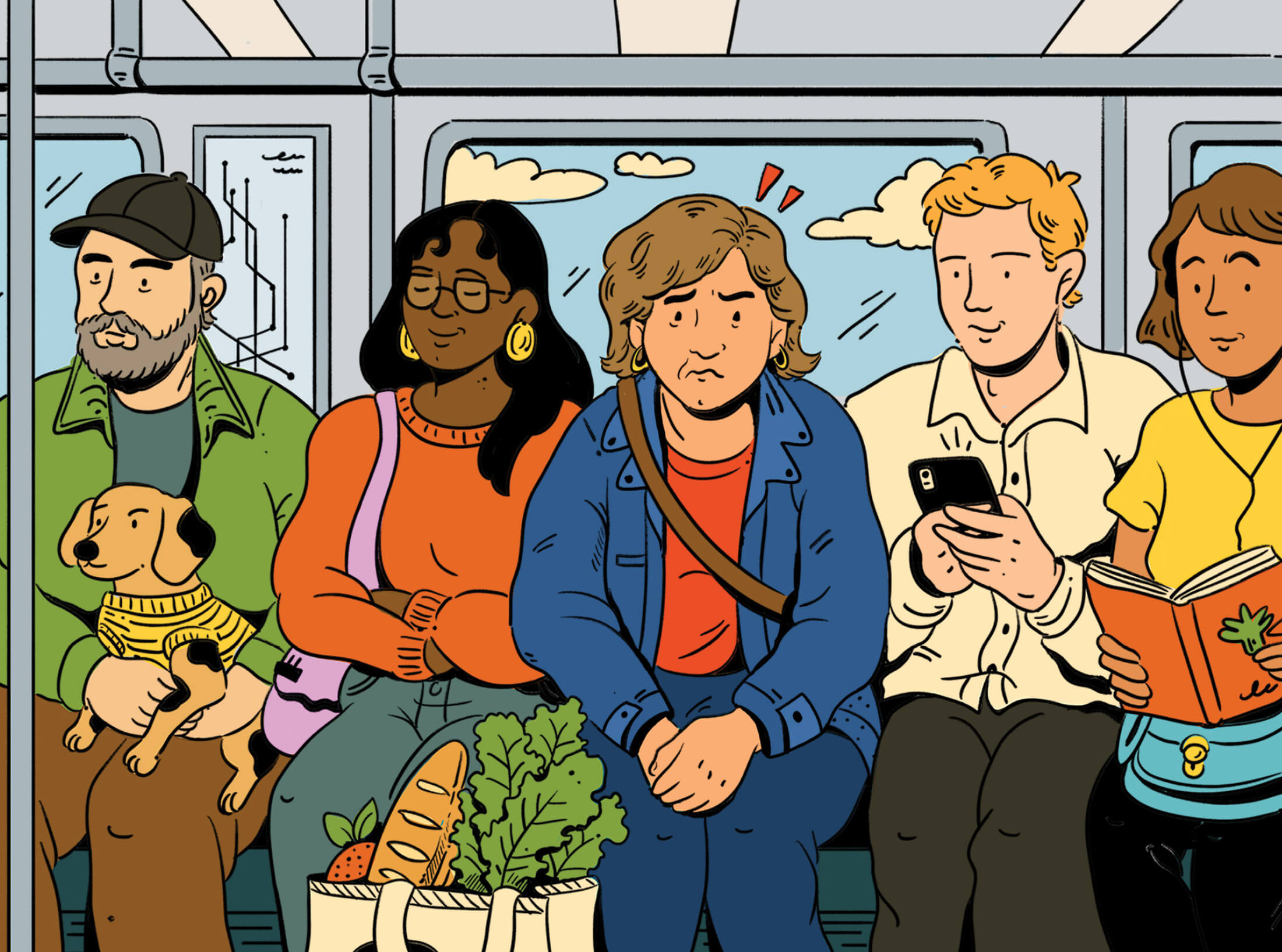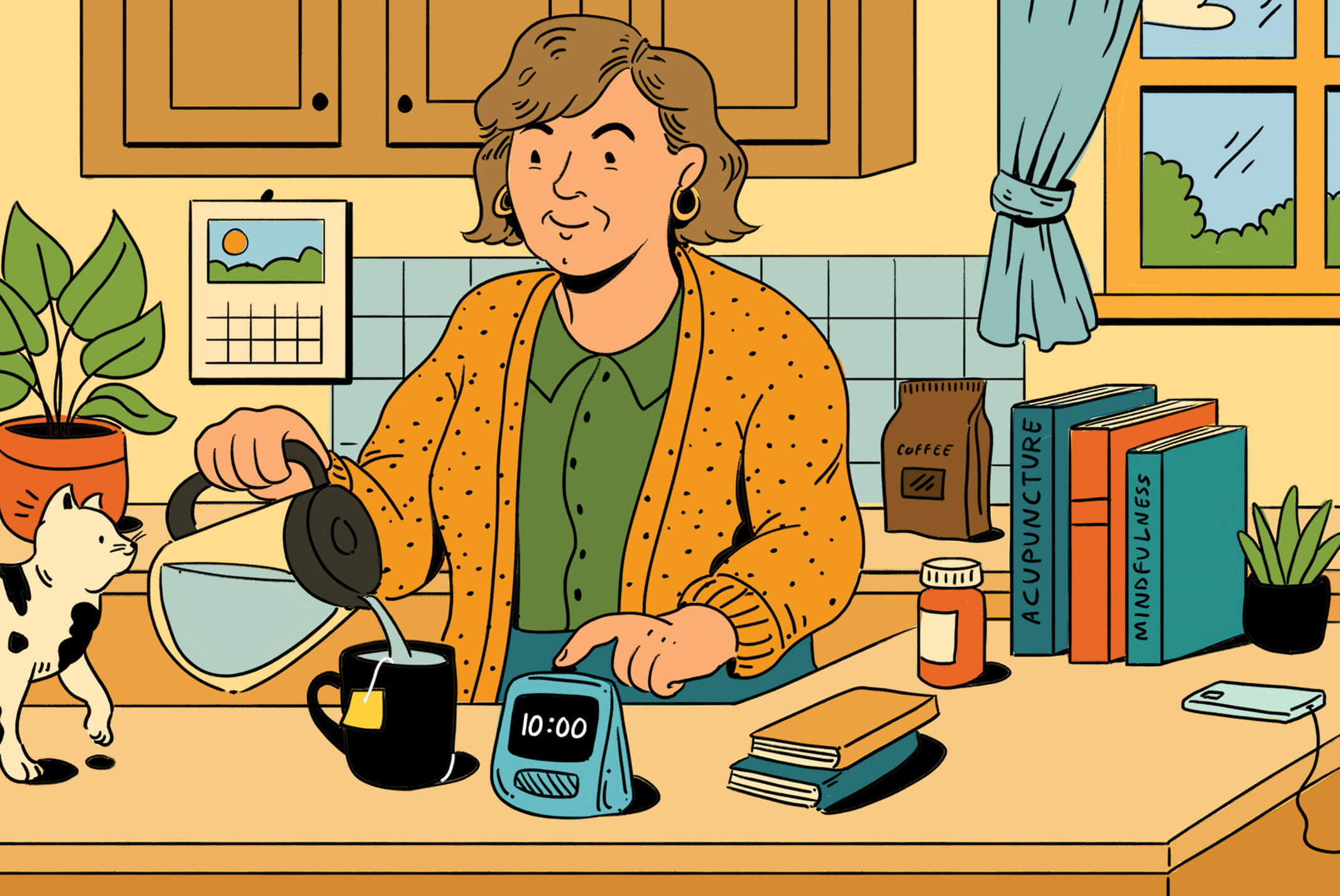Your Health
GOTTA GO?
9 strategies to calm an overanxious bladder
BY MICHELLE CROUCH
ILLUSTRATIONS BY AMBER DAY

The world is full of adventure and opportunity. But many of us miss those opportunities because we’re busy doing something else: looking for a restroom.
Constantly having to run to the loo, or waking up several times during the night to feel our way to the bathroom: It’s what doctors call frequent urination, a common condition among older adults.
Many people who have frequent urination also have overactive bladder, a condition in which you get an overwhelming urge to go that comes on suddenly and is difficult to control. Urine may leak out if you don’t get to the bathroom fast enough. As many as 30 percent of men and 40 percent of women experience this problem at least sometimes, according to the Urology Care Foundation.
Frequent urination isn’t harmful. But it can be embarrassing and annoying, especially if that gotta-go feeling is keeping you from activities you enjoy. And if you wake up a lot to pee in the night, you should know disturbed sleep has been linked to health conditions including diabetes, heart disease and dementia.
Many older adults assume that peeing frequently is a part of normal aging. That’s not the case, says Elizabeth Braxton, a urogynecologist with Novant Health Pelvic Health Center in Winston-Salem, North Carolina.
“It’s definitely more common as you age, but it’s not normal,” she says. If you feel as if you are urinating too often—or if you’re always thinking about where the nearest bathroom is—you should talk to your doctor about possible causes, Braxton says.
Frequent urination can be a sign of a more serious condition, such as diabetes, a urinary tract infection, interstitial cystitis or an enlarged prostate. It can also be a side effect of some medications, particularly diuretics. Sometimes simply changing how and when you take your medications can make a big difference, Braxton says.
Whether or not you have an underlying condition, a constant urge to go isn’t something you have to live with. The following steps could help calm your cranky bladder.
1. DRINK WATER WISELY
Many people guzzle the often recommended eight glasses of water a day, but there’s no science behind that number, says Karyn Eilber, a board-certified urologist at Cedars-Sinai Medical Center in Los Angeles.
“If you have a large person working outside, sweating, they probably need more than that,” Eilber says. “But a petite person who sits at a desk all day probably needs much less.”
However, if you don’t drink enough fluids, that too can trigger more trips to the bathroom, says Aleece Fosnight, a board-certified physician assistant specializing in urology at Aeroflow Urology near Asheville, North Carolina. “It sounds counterintuitive, but urine is made up of waste products, and it’s very irritating to the body,” Fosnight explains. “The more concentrated your urine is, the more irritating it is, and that gives you the urge to go.”
Let your thirst guide you, but aim for a minimum of 40 ounces of fluid a day—that’s about five glasses. Your urine color is another clue: It should be light to medium yellow.
2. MONITOR YOUR DIET
In one study, men who drank two cups of coffee a day were 72 percent more likely to have bladder problems, including frequent urination and leakage. Many other studies show the same association in women.
But caffeine isn’t the only culprit. Other known bladder irritants are alcohol, spicy foods, high-acid foods such as citrus and tomatoes, chocolate, artificial sweeteners and carbonated beverages, including unsweetened seltzer water.
Experts recommend giving up all those foods and beverages for two weeks and then reintroducing them to your diet one at a time to see which ones are triggers.
3. DON’T GO ‘JUST IN CASE’
Going to the bathroom before you feel the urge can actually worsen urination frequency, Braxton says.
Most people sense that their bladder is full about 10 to 15 minutes before they really need to go, Fosnight explains. If you routinely go before that sensation kicks in, the nerves in your bladder will adapt and start signaling to the brain that you need to go sooner.
“When your bladder is half full, you’ll start to have the same sensation you used to have when it was three-quarters full,” she says. “That line of capacity drops down.”

4. TRY TO HOLD OFF AWHILE
One of the most effective strategies is to not pee for 10 to 15 minutes after you first feel the urge, with the goal of building up from there. (Don’t go crazy: Regularly holding your pee for extended amounts of time—five hours or more—may increase your risk of a urinary tract infection or incontinence.)
Sitting down can help you hold off because it places pressure on the pudendal nerve, which “causes a reflex quieting of the bladder,” says Jill Rabin, a urogynecologist and coauthor of Mind Over Bladder: A Step-by-Step Guide to Achieving Continence.
Contracting your pelvic floor muscles (doing Kegel exercises; see “How to Kegel,” at below) also calms the bladder and can make it easier to wait, Braxton says. “I tell my patients to take big, slow, deep breaths, then close your eyes, contract your pelvic floor muscles and consciously tell your bladder to calm down.”
5. SET A BATHROOM SCHEDULE
For even more control, consider a behavioral therapy called “timed voiding.” Track how often you go to the bathroom and then set a schedule that adds 10 or 15 minutes to the interval between toilet breaks. So, for example, if you typically urinate every 45 minutes, try to go every hour. Follow the schedule even if you don’t feel as if you have to go. After a week, add another 15 minutes. Keep increasing the interval until you can last at least two hours between bathroom visits.
6. TRY MINDFUL MEDITATION
Several small studies have found that mindfulness and meditation can help with overactive bladder. At the Loyola University Chicago Health System, for example, a small group of women who listened to a 15-minute guided meditation twice a day for two weeks reduced their number of incontinence episodes from 38 per week to about 12. Subjects underwent a series of relaxation exercises and then were asked to picture the physical connection between their bladder and brain, visualizing the part of the brain that controls the bladder getting stronger and stronger.
7. CONSIDER ACUPUNCTURE
Some patients find that acupuncture can help minimize those mad dashes to the bathroom. Acupuncture stimulates strategic points on the body with super-thin needles. New techniques also send an electric current through the needles. A 2022 Cochrane review of 15 studies with 1,395 patients determined that acupuncture was slightly better than medication at improving the symptoms of overactive bladder, although the researchers noted that more high-quality research was needed. Acupuncture also had fewer side effects than medication, the review showed.
8. CUT DOWN ON NIGHTTIME FLUIDS
If you find yourself hitting the bathroom more than once a night, try to minimize how much fluid you drink after 6 p.m.
As many as 60 percent of adults over 70 wake up two times or more during the night to pee, studies show. Besides making you feel tired the next day, frequent nighttime awakenings have been linked to a lower quality of life, depression and a higher risk of falls.
Taking a diuretic, or water pill, for high blood pressure or a heart condition just before bed can exacerbate the problem, Braxton says. She recommends asking your doctor if you can take it earlier in the day instead.
9. SEEK MEDICAL INTERVENTION
If you have overactive bladder, your doctor can prescribe a medication to help weaken the urge to urinate. Other treatments include nerve stimulation, Botox injections or, if you have a severe case, surgery to implant a “bladder pacemaker” that can help control bladder function.
Michelle Crouch is a contributing writer who covers health and personal finance.
HOW TO KEGEL
Both men and women can benefit
▶︎ Identify the right muscles by trying to stop your urine stream mid-flow.
▶︎ You can do a Kegel anywhere, but lying down might be easier at first.
▶︎ Practice Kegels with an empty bladder.
▶︎ For a short muscle contraction, quickly tighten the muscle for one or two seconds and release for one or two seconds.
▶︎ For a long-hold contraction, gradually tighten the muscle for three seconds, then relax for three seconds.
▶︎ Work up to a five-second Kegel, then relax for five seconds. Eventually, work up to a 10-second contraction with a 10-second rest.
For more details, visit nafc.org/kegel-exercises for the National Association for Continence’s free, step-by-step guide.